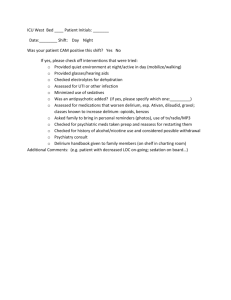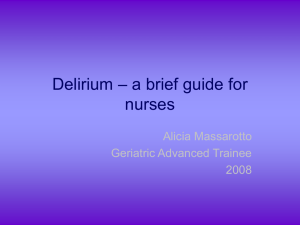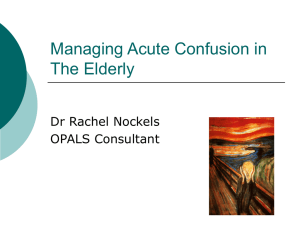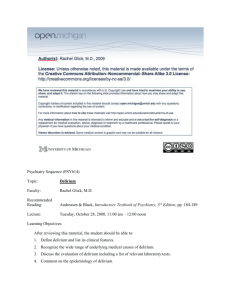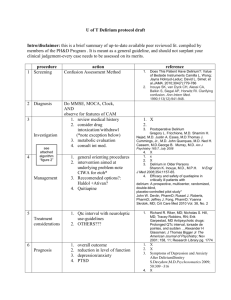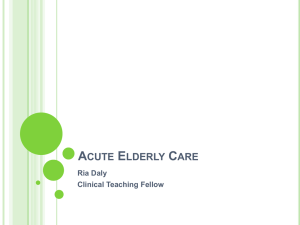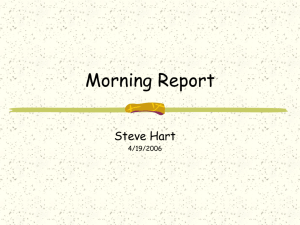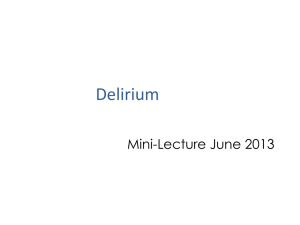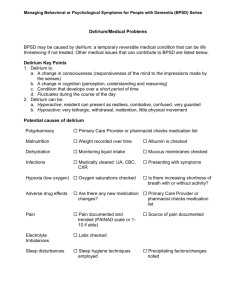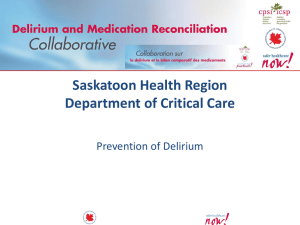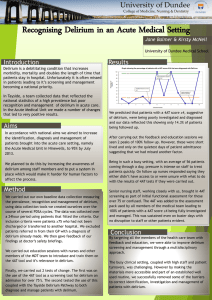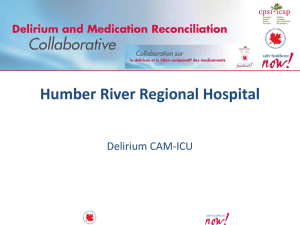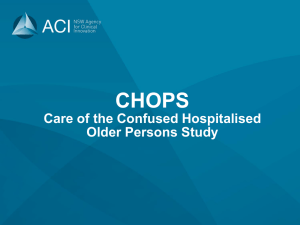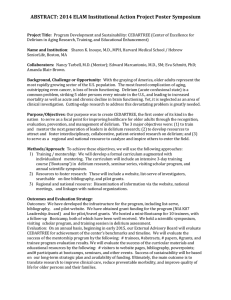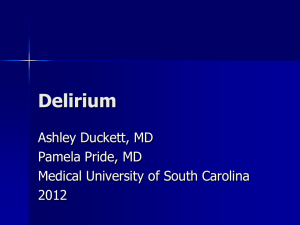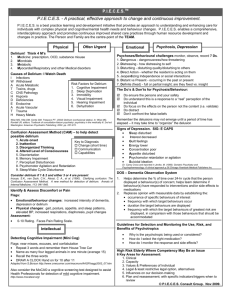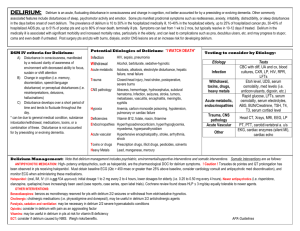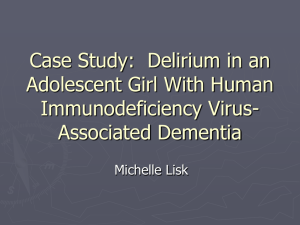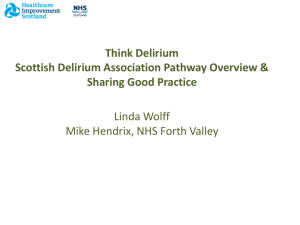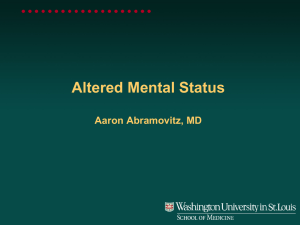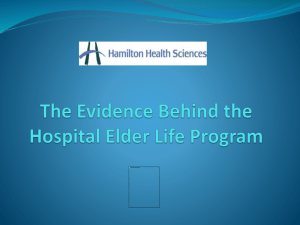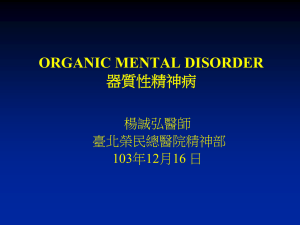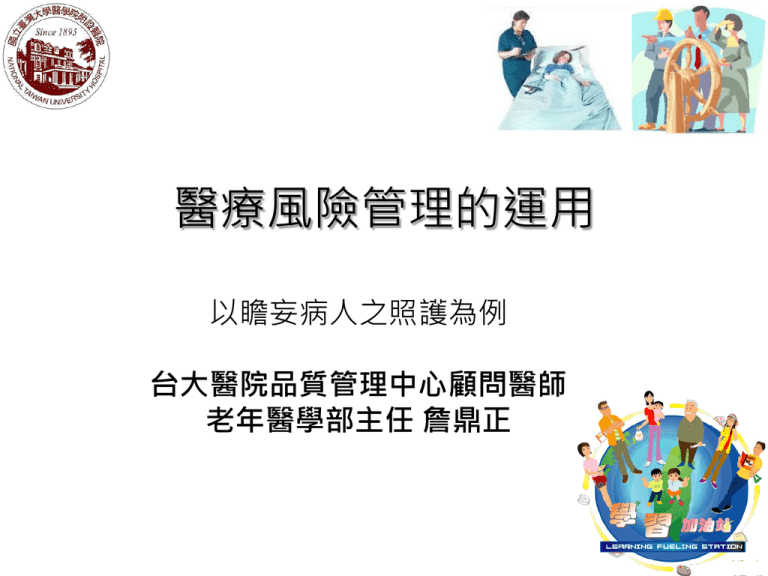
醫療風險管理的運用
以瞻妄病人之照護為例
台大醫院品質管理中心顧問醫師
老年醫學部主任 詹鼎正
譫妄DELIRIUM 又稱為•
•
•
•
•
•
•
•
acute confusional state
acute mental status change
altered mental status
organic brain syndrome
reversible dementia
toxic or metabolic encephalopathy
dysergastic reaction
subacute befuddlement
譫妄常見嗎?
• 內科住院病人:約5~10%
• 一般住院老人:約14~24%
• ICU病人:高達70-87%
• 住院期間跟譫妄相關之死亡率達22~76%
• 可能衍變為慢性疾病,或產生永久後遺症
Resource: Practice guideline for the treatment of patients with delirium. American Psychiatric Association. Am J Psychiatry 1999; 156: 1-20.
老年譫妄症,劉建良、陳亮恭,台灣老年醫學暨老年學雜誌 2011;6(1):1-14
3
就算出院一年後,
曾發生譫妄的病人還是有較差的存活率
Slide 4
4
為什麼一再發生?
• 臨床正確診斷機率僅:18~57%不等
• 對譫妄特性之認知不足 (風險辨識)
• 缺乏正確評估譫妄症的能力 (風險評估)
• 評估結果是否有效傳遞 (溝通有效性)
5
如何診斷譫妄症?
DSM-V. 2013.
6
譫妄診斷工具
Confusion Assessment Method
Requires features 1 and 2 and
either 3 or 4:
1. Acute change in mental status
and fluctuating course
2. Inattention
3. Disorganized thinking
4. Altered level of consciousness
7
譫妄的分類
• Hyperactive or agitated delirium
– 25% of all cases
• Hypoactive delirium
– less recognized or appropriately treated
• Mixed
• Additional features include emotional symptoms,
psychotic symptoms, “sundowning”
8
譫妄的形成模式
• Predisposing factors
•
•
High vulnerability
Low vulnerability
Precipitating factors
Noxious insult
Less noxious insult
9
PREDISPOSING FACTORS (無法改變的)
•
•
•
•
•
•
•
Advanced age
Dementia
Functional impairment in ADLs
Medical comorbidity
History of alcohol abuse
Male sex
Sensory impairment (vision, hearing)
10
PRECIPITATING FACTORS
(臨床需要尋找及處理的)
•
•
•
•
Acute cardiac events
Acute pulmonary events
Bed rest
Drug withdrawal
(sedatives, alcohol)
• Fecal impaction
• Fluid or electrolyte
disturbances
• Indwelling devices
Slide 11
• Infections
(esp. respiratory, urinary)
•
•
•
•
•
Medications
Restraints
Severe anemia
Uncontrolled pain
Urinary retention
11
好背的口訣(AEIOU tips)
Alcohol 酒精(震顫譫妄)
Epilepsy 癲癇
Insulin 胰島素(高或低血糖)
Overdose 藥物過量
Uremia 尿毒症(代謝性腦病變之代表)
Trauma or Tumor 頭部外傷或腦部腫瘤
Infection 感染症(中樞神經或全身性)
Psychiatric 精神病
Stroke 中風
12
譫妄評估處置流程圖
Slide 13
13
病史與身體檢查
• History
– Focus on time course of cognitive changes, esp. their
association with other symptoms or events
– Medication review, including OTC drugs, alcohol
• Physical examination
–
–
–
–
Vital signs
Oxygen saturation
General medical evaluation
Neurologic and mental status examination
14
檢驗與檢查
– Base on history and physical
– Include CBC, electrolytes, renal function tests
– Also helpful: UA , LFTs, serum drug levels, arterial blood
gases, chest x-ray, ECG, cultures
– Cerebral imaging rarely helpful, except with head trauma or
new focal neurologic findings
– EEG and CSF rarely yield helpful results, except with
associated seizure activity or signs of meningitis
15
治療方針
• Treat the underlying disease
• Address contributing factors
• Avoid the complications of delirium by:
- removing indwelling devices ASAP
- preventing or treating constipation and urinary
retention
- encouraging proper sleep hygiene, avoiding sedatives
• Optimize medication regimen (see next slide)
16
藥物回顧很重要
Almost any medication if time course is appropriate
•
•
•
•
•
•
•
Alcohol
Antibiotics
Anticholinergics
Anticonvulsants
Antidepressants
Antihistamines
Antiparkinsonian
agents
• Antipsychotics
•
•
•
•
•
•
Barbiturates
Benzodiazepines
Chloral hydrate
H2-blocking agents
Lithium
Opioid analgesics (esp.
meperidine)
17
過激症狀的處理
•
•
•
•
Provide “social” restraints
Consider a sitter or allow family to stay in room
Avoid physical or pharmacologic restraints
If absolutely necessary, use haloperidol
(or atypical antipsychotoics
- for mild delirium: 0.25-0.5 mg po or 0.125-0.25 mg IV/IM
- for severe delirium: 0.5-2 mg IV/IM
- additional dosing q 60 min, as required
- assess for akathisia and extrapyramidal effects
- avoid in older persons with parkinsonism
- in ICU, monitor for QT interval prolongation, torsade de pointes,
neuroleptic malignant syndrome, withdrawal dyskinesias
18
–Regular re-orienting
communication
Slide 19
19
避免約束
• The highest relative risk of the precipitating factors for
delirium*
• Significant association with the severity of delirium†
• Misconceived reason for physical restraint use among
delirious patients to prevent injury
• Restraint reduction: not associated with falls
• Restraint free care: the standard of care
*Inouye
SK, et al. JAMA. 1996;275(11):852–857.
†McCusker J, et al. J Am Geriatr Soc. 2001;49(10):1327–1334.
20
加強復健
• Use orienting stimuli (clocks, calendar, radio)
• Provide adequate socialization
• Use eyeglasses and hearing aids appropriately
• Mobilize patient as soon as possible
• Ensure adequate intake of nutrition and fluids, if necessary by
hand feeding
• Educate and support the patient and family
21
預防重於治療
• The Yale Delirium Prevention Trial
– Orientation and activities for cognitive impairment
– Early mobilization to avert immobilization
– Nonpharmacologic approach to minimize drug use
– Interventions to prevent sleep deprivation
– Equipment for vision and hearing impairment
– Early intervention for volume depletion
• Limit or avoid psychoactive and other high-risk medications
22
The Yale Delirium Prevention Trial
P = 0.03 by log-rank test
23
急性瞻妄-躁動案例
背景說明
• 病人為77歲男性,原本即罹患慢性骨髓性白血病 (CML) ,治療遵從
性不佳,病情有惡化現象。門診時與主治醫師討論待肺炎好轉後進一
步安排骨髓檢查。
24
我們看到了甚麼問題?
處理認知不足
• 未正確進行風險評估(藥物因素/內出血…)
病情掌握有限
• 而非主責的醫師進行病人照顧
• 未執行預防性策略
• 未能進行有效的病情傳遞
病情照護
• 未持續監測病人生命徵象
家屬衛教
• 未教導家屬需觀察點
• 未積極通報病人病情
• 未與家屬取得有效溝通
25
避免相同的事件再發生
26
臨床風險辨識
• 臨床上的表徵
– 如意識混亂、瞳孔放大、胡言亂語、定向感障礙,視幻覺、
觸幻覺,以及激躁不安、嗜睡、類似癲癇大發作的抽搐,攻擊
行為等
• 高風險族群
– 老年病人、失智病人
– 常見於加護單位
• 高風險行為
– 自拔管路
– 跌倒
27
對於瞻妄症狀的風險控制
「預防勝於治療」&「找出病因,對症治療」
1.預防
1)
2)
3)
4)
每日固定的常規活動。
固定的照顧者
提供夜間適當休息及睡眠,避免過度或不當使用鎮靜安眠藥。
避免不必要的約束
2.治療
1) 足夠的敏感度及警覺性,及早發現,做必要診治。
2) 確認並矯正會造成譫妄的原因(鑑別診斷)。
3) 依需要照會專家
28
Risk & Mitigation strategies
Risk
Mitigation
傷害程度
減輕傷害&立即處理
確立問題
通知主治醫師/
依需要照會專家
多人團隊/溝通問題
單位內召開會議統一一人向家屬說明
醫療爭議
轉介關懷小組
29
瞻妄病人照護指引
對於焦慮躁
動的處置,
首先考慮非
藥物的處置
身體評估:
瞻妄病人鑑
別診斷
(AEIOU tips)
進一步通報
總醫師/主治
醫師與照會
專家
持續監測
病人狀況
臺大醫院品質管理中心小提醒
30
我們還可以做甚麼?
在照護方式:建構親和環境
Airway, Breathing, Circulation
監測vital signs及I/O
必要時給予氧氣
注意病人可能之傷害行為
必要時予以約束
注意所服藥物的副作用
必要時提醒醫師
在醫學處置方面:
沒有絕對的治療方式
用藥安全:鬆弛劑的使用更需小
心
對不同病人不同病情都需審慎評
估
在護理人員方面:
使用和病人相符的溝通模式,例
如單子或短句 。
在說話時要採用低音調、低音
量以及緩慢的速度。
當病人不瞭解溝通內容的時候,
要重複傳遞訊息並增加手部的
動作。
也可以運用輕觸覺刺激,譬如擁
抱、撫摸、拍打來表達構成。
31
躁動不安病人其他照護原則
最重要的是「預防勝於治療」及「找出病因
,對症治療」。(鑑別診斷)
要有足夠的敏感度及警覺性,及早發現,做
必要診治。
32
病
人
結論
• 當有些人望著你的時候,她們看到的只是一個診斷結果、
一個麻煩、一種類別,而不是一個完整的人格。
• 唯有站在同樣的角度看世界才會感受到真正的關切
(取自LETTERS TO SAM: A GRANDFATHER’S LESSONS ON LOVE, LOSS, AND THE GIFTS OF
LIFE, DANIEL GOTTLIEB,2007)
全人看待
全人評估
33
Thanks for Attention!!
2014.07.26
34

